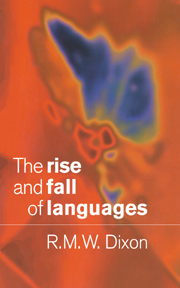Book contents
- Frontmatter
- Contents
- Acknowledgements
- 1 Introduction
- 2 Preliminaries
- 3 Linguistic areas and diffusion
- 4 The family tree model
- 5 Modes of change
- 6 The punctuated equilibrium model
- 7 More on proto-languages
- 8 Recent history
- 9 Today's priorities
- 10 Summary and prospects
- Appendix – where the comparative method discovery procedure fails
- References
- Index
3 - Linguistic areas and diffusion
Published online by Cambridge University Press: 05 June 2012
- Frontmatter
- Contents
- Acknowledgements
- 1 Introduction
- 2 Preliminaries
- 3 Linguistic areas and diffusion
- 4 The family tree model
- 5 Modes of change
- 6 The punctuated equilibrium model
- 7 More on proto-languages
- 8 Recent history
- 9 Today's priorities
- 10 Summary and prospects
- Appendix – where the comparative method discovery procedure fails
- References
- Index
Summary
If two languages are in contact – some of the speakers of each having a degree of competence in the other – they are likely to borrow lexemes, grammatical categories and techniques, and some grammatical forms (in at least one direction, often in both directions) and gradually become more similar.
If a number of languages are spoken in a geographically continuous area – which contains no physical or social impediments to cross-cultural communication – there will in each language community be a degree of multilingualism. A number of linguistic traits will diffuse from language to language until each applies across a considerable region within the geographical area, sometimes across the whole area. Each language has two possible kinds of similarities to other languages – genetic similarities, which are shared inheritances from a common proto-language; and areal similarities, which are due to borrowing from geographical neighbours. Emeneau (1956:16) defined ‘linguistic area’ as ‘an area which includes languages belonging to more than one family but showing traits in common which are found not to belong to other members of (at least) one of the families’. This is a readily recognisable area. We could equally well have an area which includes all the languages of each of several families (no language from any of the families being located outside the area). If the languages from each family were scattered over the area, rather than each being in a solid block, then it might be possible to distinguish genetic from areal similarities. (Lowland Amazonia is a linguistic area essentially of this type.)
- Type
- Chapter
- Information
- The Rise and Fall of Languages , pp. 15 - 27Publisher: Cambridge University PressPrint publication year: 1997



